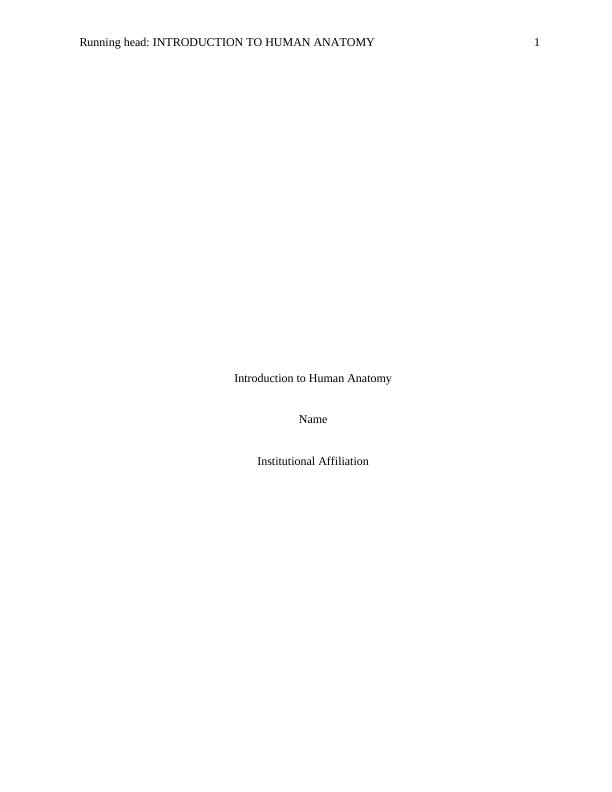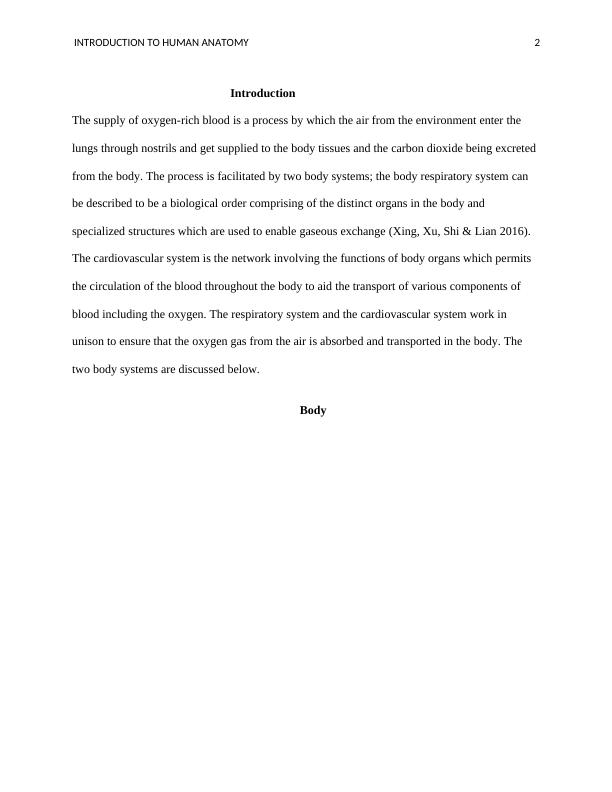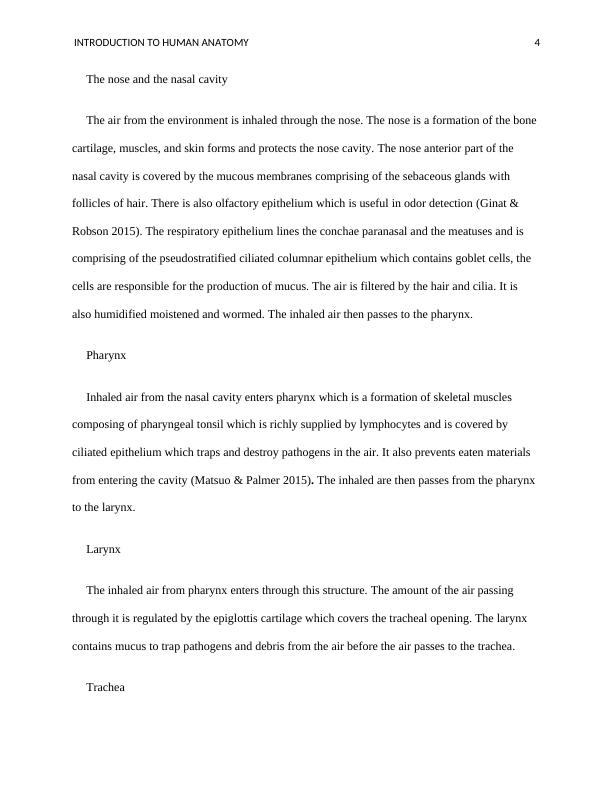Introduction to Human Anatomy
Added on 2023-04-06
11 Pages1644 Words358 Views
Running head: INTRODUCTION TO HUMAN ANATOMY 1
Introduction to Human Anatomy
Name
Institutional Affiliation
Introduction to Human Anatomy
Name
Institutional Affiliation

INTRODUCTION TO HUMAN ANATOMY 2
Introduction
The supply of oxygen-rich blood is a process by which the air from the environment enter the
lungs through nostrils and get supplied to the body tissues and the carbon dioxide being excreted
from the body. The process is facilitated by two body systems; the body respiratory system can
be described to be a biological order comprising of the distinct organs in the body and
specialized structures which are used to enable gaseous exchange (Xing, Xu, Shi & Lian 2016).
The cardiovascular system is the network involving the functions of body organs which permits
the circulation of the blood throughout the body to aid the transport of various components of
blood including the oxygen. The respiratory system and the cardiovascular system work in
unison to ensure that the oxygen gas from the air is absorbed and transported in the body. The
two body systems are discussed below.
Body
Introduction
The supply of oxygen-rich blood is a process by which the air from the environment enter the
lungs through nostrils and get supplied to the body tissues and the carbon dioxide being excreted
from the body. The process is facilitated by two body systems; the body respiratory system can
be described to be a biological order comprising of the distinct organs in the body and
specialized structures which are used to enable gaseous exchange (Xing, Xu, Shi & Lian 2016).
The cardiovascular system is the network involving the functions of body organs which permits
the circulation of the blood throughout the body to aid the transport of various components of
blood including the oxygen. The respiratory system and the cardiovascular system work in
unison to ensure that the oxygen gas from the air is absorbed and transported in the body. The
two body systems are discussed below.
Body

INTRODUCTION TO HUMAN ANATOMY 3
Figure 1. Labeled diagram of the respiratory system, Respiratory system by Kim
Zimmermann,2018, https://www.google.com/url?
sa=i&source=images&cd=&ved=2ahUKEwiwupfSu_fhAhVSRBoKHYyADdkQjRx6BAgBEA
U&url=https%3A%2F%2Fwww.topsimages.com%2Fimages%2Fgreat-respiratory-system-body-
shop-
09.html&psig=AOvVaw1qFmpa5Mo8hDN5VfHHOPRF&ust=1556701631020026.Copyright
2018 by Kim Zimmermann. Reprinted with permission.
The system comprises of several tissues and organs which include-
Figure 1. Labeled diagram of the respiratory system, Respiratory system by Kim
Zimmermann,2018, https://www.google.com/url?
sa=i&source=images&cd=&ved=2ahUKEwiwupfSu_fhAhVSRBoKHYyADdkQjRx6BAgBEA
U&url=https%3A%2F%2Fwww.topsimages.com%2Fimages%2Fgreat-respiratory-system-body-
shop-
09.html&psig=AOvVaw1qFmpa5Mo8hDN5VfHHOPRF&ust=1556701631020026.Copyright
2018 by Kim Zimmermann. Reprinted with permission.
The system comprises of several tissues and organs which include-

INTRODUCTION TO HUMAN ANATOMY 4
The nose and the nasal cavity
The air from the environment is inhaled through the nose. The nose is a formation of the bone
cartilage, muscles, and skin forms and protects the nose cavity. The nose anterior part of the
nasal cavity is covered by the mucous membranes comprising of the sebaceous glands with
follicles of hair. There is also olfactory epithelium which is useful in odor detection (Ginat &
Robson 2015). The respiratory epithelium lines the conchae paranasal and the meatuses and is
comprising of the pseudostratified ciliated columnar epithelium which contains goblet cells, the
cells are responsible for the production of mucus. The air is filtered by the hair and cilia. It is
also humidified moistened and wormed. The inhaled air then passes to the pharynx.
Pharynx
Inhaled air from the nasal cavity enters pharynx which is a formation of skeletal muscles
composing of pharyngeal tonsil which is richly supplied by lymphocytes and is covered by
ciliated epithelium which traps and destroy pathogens in the air. It also prevents eaten materials
from entering the cavity (Matsuo & Palmer 2015). The inhaled are then passes from the pharynx
to the larynx.
Larynx
The inhaled air from pharynx enters through this structure. The amount of the air passing
through it is regulated by the epiglottis cartilage which covers the tracheal opening. The larynx
contains mucus to trap pathogens and debris from the air before the air passes to the trachea.
Trachea
The nose and the nasal cavity
The air from the environment is inhaled through the nose. The nose is a formation of the bone
cartilage, muscles, and skin forms and protects the nose cavity. The nose anterior part of the
nasal cavity is covered by the mucous membranes comprising of the sebaceous glands with
follicles of hair. There is also olfactory epithelium which is useful in odor detection (Ginat &
Robson 2015). The respiratory epithelium lines the conchae paranasal and the meatuses and is
comprising of the pseudostratified ciliated columnar epithelium which contains goblet cells, the
cells are responsible for the production of mucus. The air is filtered by the hair and cilia. It is
also humidified moistened and wormed. The inhaled air then passes to the pharynx.
Pharynx
Inhaled air from the nasal cavity enters pharynx which is a formation of skeletal muscles
composing of pharyngeal tonsil which is richly supplied by lymphocytes and is covered by
ciliated epithelium which traps and destroy pathogens in the air. It also prevents eaten materials
from entering the cavity (Matsuo & Palmer 2015). The inhaled are then passes from the pharynx
to the larynx.
Larynx
The inhaled air from pharynx enters through this structure. The amount of the air passing
through it is regulated by the epiglottis cartilage which covers the tracheal opening. The larynx
contains mucus to trap pathogens and debris from the air before the air passes to the trachea.
Trachea

End of preview
Want to access all the pages? Upload your documents or become a member.
Related Documents
Fundamentals of Human Anatomy and Physiology: Respiratory System Worksheetlg...
|8
|2117
|4
Anatomy and Physiology - Assignmentlg...
|13
|3527
|337
Respiratory Systemlg...
|16
|2909
|483
Human Respiratory and Cardiac Systemslg...
|26
|3751
|23
Role of Respiratory Systemlg...
|15
|1097
|17
Managing Care of the Adult Patient Assignmentlg...
|14
|4307
|133
